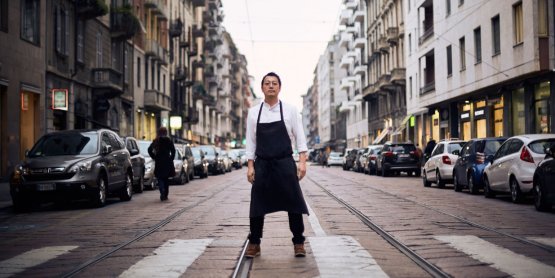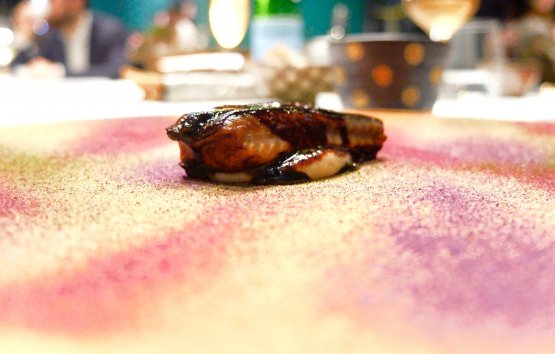«Me always try ne things». That is to say, in Japanese-Italian, “the pleasure and adrenalin of a challenge, the excitement that comes from taking on a new adventure”, as we wrote here in January 2015, announcing – in his words and ours – the approaching opening of Yoji Tokuyoshi’s restaurant in Milan. Several months later, we can say he won the challenge: not just in general, in that at Tokuyoshi “the food is good”, which is in fact a necessary and sufficient condition. But there’s more: Massimo Bottura’s ex sous chef follows with determination his very interesting intention to presenting a personal style, which in many ways is new and has certainly no pairs in town, «my cooking is Italian with 100% local produce. However the way I present dishes, my cooking techniques and philosophy are my own. I’m a hybrid». Not that he takes jokes of our tradition, but he gives it a new perspective: Japanese aesthetics, Italian flavours. He floats serenely between two close and very distant culinary cultures, trying a chimeric balance. And it looks like he’s found it.

According to him «the ancient Japanese school requires the utmost respect for ingredients, which give life to flavours as clear as water. Meanwhile, Italian tradition represents the earth, because it has its tradition linked with every territory». So one shouldn’t be surprised that
Tokuyoshi’s cooking offers a new, refined harmony between the two elements. Every dish includes a liquid part – a hot broth, a cold juice, an extract – which remains separated on the table, in a cup on the side, but refers to Japanese rituals: «We recommend our guests to sip the liquid part between mouthfuls», says sommelier
Alfonso Bonvini. As with
“Gyotaku” Mackerel, a word that doesn’t exist in the Japanese culinary tradition and refers to the printed image of a fish. «We take this custom by “printing” the mackerel on the plate, and then enriching it with a mousse of scallops, lemon, mandarin zest, wild fennel and squid ink».
This was one of the initial tastings in a truly fascinating dinner that had already included some super-appetizers such as the extraordinary Piadina with burrata, sea urchin and plankton sauce, capable of becoming almost as addictive as the butter served at the beginning (which is not just butter: it’s hazelnut butter, mascarpone and Greek yogurt) which you can spread on the excellent mother yeast bread, with cherry juice as a starter. So good it inspired Tokuyoshi also Bread butter and anchovies, in which the butter is the same but the bread is steamed, Japanese style. These first tastings already reveal the format: with the amuse bouche they served a broth with discarded vegetables, with the piadina a broth of roasted potatoes, with the mackerel pine nut milk.

Eel lacquered in balsamic vinegar from Modena, soused fish sauce, powdered dehydrated vegetables
The following step is extraordinary:
Eel lacquered in balsamic vinegar from Modena, soused fish sauce, powdered dehydrated vegetables (beetroot, carrot and purple cabbage): the presentation is beautiful, the echo of Emilia is amplified by the broth served with it, “Via Emilia”, made from an infusion of mortadella, capon, Parmigiano Reggiano and prosciutto.
However, the call of the territory is not limited to the lands Yoji got to know well during his nine years at Osteria Francescana: we go to Sicily, with Omaggio a Noto, that is to say spaghetti Mancini whose cooking ended in almond milk, then clams, pistachio and powdered coffee with a grappa of Frappato byArianna Occhipinti aromatized with capers. To tell the truth, the seasoning would be even too concentrated, too thick, without the aid of the sweet-acid and aromatic marvel of an extract of green olives and tomato water. By far the best sip during the dinner. A masterpiece.

Suckling pig covered in dehydrated leaves with leaves of bread aromatised with spinach
The same now applies to the
Fake risotto alla milanese, one of the first dishes he presented in Via San Calocero, which we had already tasted: it has reached a final and convincing balance, with the grains of celeriac as creamy as in a risotto, and on top a katsuobushi made with a film of rice and saffron (paired with whole rice saké with shitake and meat broth). An excellent representation of this embrace between Italy and Japan is given by
Onion chips with venison from the Tuscan-Emilian Apennine and wagyu from Totori, where
Tokuyoshi was born: a new dish – which shows the accomplished harmony, and a now controlled tone. Another balanced dish is
Winter duck with furikake, its jus, grilled beetroot, scorzonera truffle, liver with crispy cocoa chips, served with a juice of fruits of the forest. In between there was the
Suckling pig covered in dehydrated leaves with leaves of bread aromatised with spinach and cherry and rhubarb juice, which recalls the aesthetics of
Ossobuco dressed for the winter of which we
wrote not enthusiastically in the past: in this case instead it is totally convincing, just like the following
Head coppa and gnocco fritto.
Finally, the dessert, which as often the case are one step below the rest: Aubergine panna cotta, with lemon granita and grated squaquerone, and the new Monte Rosa. Even in this case it recalls the aesthetics of a dish from last year, Cemento e Terra: but in that case it was more rigorous, cerebral, while this is more sugary and craveable: a sponge cake base, chestnut cream, truffle, quince apple ice cream, apples from Valtellina, beetroot wafers.